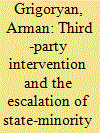|
|
|
Sort Order |
|
|
|
Items / Page
|
|
|
|
|
|
|
| Srl | Item |
| 1 |
ID:
138172


|
|
|
|
|
| Summary/Abstract |
When do newly independent states employ coercive measures against restive ethnic minorities within their borders rather than offer them concessions? The more vulnerable a state is to a particular minority’s bid for secession, the more likely it is to use coercion against that minority.
|
|
|
|
|
|
|
|
|
|
|
|
|
|
|
|
| 2 |
ID:
174119


|
|
|
|
|
| Summary/Abstract |
When a mass movement broke out in 2013 against the corrupt government of Viktor Yanukovich in Ukraine, the United States and its West European allies mobilized to support it. The policy was justified by the Wilsonian logic of promoting democracy and celebrated as such by liberals. Realists for the most part agreed with the liberal argument regarding the motive of that support, but criticized it as delusional and argued that the subsequent civil war in Ukraine was the consequence of that policy. This is a puzzle, because five years prior to the Ukrainian events, a mass movement had rocked Armenia— another post-Soviet state. The West's attitude toward that movement, however, ranged from indifference to hostility, even though the Wilsonian motives for supporting that movement should have been stronger. The difference in the West's response resulted from the different positions of the two movements toward Russia: the Ukrainian movement was intensely hostile toward Russia, whereas the Armenian movement was not. In other words, where Wilsonianism dovetailed with a geopolitical motive, it was triggered; where it diverged, Wilsonianism remained dormant. This is not a deviation from the general pattern either. Contrary to the popular narrative, the West has supported democracy only when that support has been reinforced by material interests, and rarely, if ever, when it has posed a threat to such interests.
|
|
|
|
|
|
|
|
|
|
|
|
|
|
|
|
| 3 |
ID:
101622


|
|
|
|
|
| Publication |
2010.
|
| Summary/Abstract |
This article addresses the problem of escalated violence against minorities induced by interventions. The conventional interventionist wisdom rejects the very possibility of such escalation, claiming that violence against minorities is a monotonically decreasing function of interventions and insisting that it is third-party inaction that is the problem. In recent years, this position has been challenged by scholars, who have argued that the threat of intervention generates a moral hazard, providing minorities with perverse incentives to provoke the very violence the threat of intervention is supposed to deter. I argue that while many of the criticisms of the interventionist position contained in this argument are correct, it is nonetheless not fully convincing, because it fails to explain why the same threat of intervention that radicalizes minorities does not make the states that are the potential targets that much more moderate. Nor does it explain adequately why interveners are unable to make the threat of intervention conditional on the minorities'"good" behavior. I propose an alternative theory of escalation, which depicts third-party interventions as instances of incomplete information bargaining, demonstrating that escalation is a function of certain distributions of private information about the target-state's level of brutality and the third party's resolve, as well as the third party's motives. The conflicts in Yugoslavia are used to illustrate and test the key implications of the model.
|
|
|
|
|
|
|
|
|
|
|
|
|
|
|
|
|
|
|
|
|